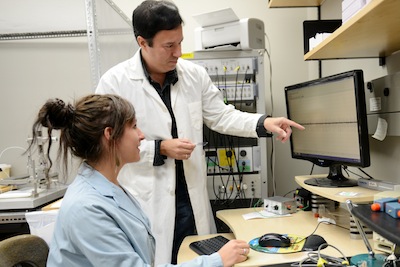
Researchers Justine Renard and Steven Laviolette discuss neuron recording results. Their new study explains how a single marijuana-like drug can have opposite effects at different doses. (Photo credit: Schulich School of Medicine & Dentistry, Western University)
A new study helps explain why the same drug can have opposite effects at different doses.
Using a drug that binds to cannabinoid receptors in the brain – the same ones that are activated by cannabis – researchers showed the precise pathway by which low doses stimulate the brain’s dopamine system, which can lead to an emotional response, including fear and paranoia. However, at high doses, the same pathway causes the dopamine system to shut down, blunting emotional responses and leading to apathetic behaviour.
The team also found that other drugs acting on different receptors could prevent these negative responses (i.e. fear/paranoia or apathy). This could offer a safer way for patients who need marijuana for pain to take the drug while reducing the emotional side effects.
Video available.
Original research paper published in the Journal of Neuroscience on September 24, 2014.
Names and affiliations of selected authors



